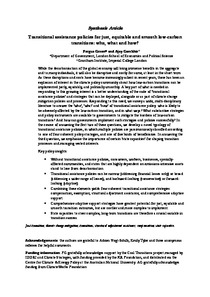Transitional assistance policies for just, equitable and smooth low-carbon transitions: who, what and how?

2020
20
8
902-921
sustainable development ; climate change ; decarbonization
Environment
https://doi.org/10.1080/14693062.2019.1657379
English
Bibliogr.
"While the decarbonization of the global economy will bring immense benefits in the aggregate and to many individuals, it will also be disruptive and costly for some, at least in the short term. As these disruptions and costs have become increasingly salient in recent years, there has been an explosion of interest in the climate policy community about how low-carbon transitions can be implemented justly, equitably, and politically smoothly. A key part of what is needed in responding to this growing interest is a better understanding of the suite of ‘transitional assistance policies' and strategies that can be deployed, alongside or as part of climate change mitigation policies and processes. Responding to this need, we survey a wide, multi-disciplinary literature to answer the ‘who', ‘what' and ‘how' of transitional assistance policy: who is likely to be adversely affected by the low-carbon transition, and in what ways? What substantive strategies and policy instruments are available to governments to mitigate the burdens of low-carbon transitions? And how can governments implement such strategies and policies successfully? In the course of answering the first two of these questions, we develop a novel typology of transitional assistance policies, in which multiple policies are parsimoniously classified according to one of four coherent policy strategies, and one of five kinds of beneficiaries. In answering the third question, we emphasize the importance of certain ‘state capacities' for shaping transition processes and managing vested interests.
Key policy insights
Without transitional assistance policies, consumers, workers, businesses, specially-affected communities, and states that are highly dependent on emissions-intensive assets stand to lose from decarbonization.
Transitional assistance policies can be narrow (addressing financial losses only) or broad (addressing a wider range of losses), and conservative (backward-looking) or adaptive (forward-looking).
Combining these elements yields four coherent transitional assistance strategies: compensation; exemption; structural adjustment assistance; and comprehensive adaptive support.
Comprehensive adaptive support strategies have greatest potential for just, equitable and smooth transition outcomes, but are costlier and more complex to implement.
State capacities to steer complex, long-term transitions are therefore a crucial variable in transition success."
The ETUI is co-funded by the European Union. Views and opinions expressed are however those of the author(s) only and do not necessarily reflect those of the European Union or the ETUI.